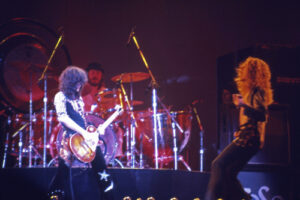
Feature Photo: Aleksandar Pasaric
Rain has long been one of the most evocative symbols in art, spanning across all mediums from music and film to television and painting. It carries a depth of meaning that can range from cleansing and redemption to sadness and loss. In cinema, rain often punctuates a turning point—think of the iconic downpours in classic films like Blade Runner or The Shawshank Redemption, where water serves as a visual metaphor for transformation and release. In visual art, rain can be captured as either gentle or torrential, often reflecting the emotional landscape of both the artist and the observer. Music, too, has embraced this theme in countless ways. Some songs harness rain as a literal force of nature, while others wield it as a metaphor for revival, sorrow, or personal growth.
This is our second exploration of rain in music, building on the deep cuts and hidden gems we covered in our previous list. This time, however, we focus on the heavy hitters—the tracks that have become synonymous with the theme of rain, not just in rock, but across genres. These are the songs that, for better or worse, are etched into the collective consciousness whenever storm clouds gather. While no list could possibly encompass the vast number of rain-inspired songs that exist, these ten are what we consider to be the most essential, capturing rain’s multifaceted symbolism in popular music. Of course, as with any list, some may lament the exclusion of their personal favorites, but when narrowing down to just ten, these are the ones we believe truly stand out.
# 10 – Rain – The Beatles
“Rain” by The Beatles is widely regarded as one of the band’s most experimental and essential tracks, marking a significant shift in their musical evolution. Released as the B-side to the chart-topping single “Paperback Writer” in 1966, the song was recorded during the sessions for the Revolver album at EMI Studios in London. Produced by George Martin and engineered by Geoff Emerick, the track stands out for its innovative use of studio techniques and forward-thinking production, solidifying The Beatles’ status as pioneers in the world of rock.
Read More: Complete List Of Beatles Band Members
# 9 – Have You Seen The Rain – Creedence Clearwater Revival
“Have You Ever Seen the Rain” is one of Creedence Clearwater Revival’s most enduring and beloved tracks. Released as a single in 1971 from the album Pendulum. At first glance, it might seem like a straightforward song about weather, but “Have You Ever Seen the Rain” is loaded with deeper meaning, both personal and universal. It was written during a turbulent time for the band, with tensions among its members growing, and its lyrics reflect a sense of impending change and disillusionment.
Read More: Top 10 Creedence Clearwater Revival Songs
# 8 – Red Rain – Peter Gabriel
“Red Rain” opens Peter Gabriel’s critically acclaimed 1986 album So with an intensity and haunting atmosphere that makes it one of his most iconic songs. Released in the United States as a promotional single, the song reached number three on the Billboard Mainstream Rock chart. Later released as a commercial single in parts of Europe, Australia, and the U.S., it peaked at number 46 on the UK Singles Chart. Its dreamlike and harrowing imagery, combined with Gabriel’s atmospheric production, set the tone for an album that became a defining moment in his career. The song was recorded in various sessions from 1985 to 1986 and was produced by Gabriel alongside Daniel Lanois, whose innovative production style helped shape the song’s rich texture.
Read More: Top 10 Peter Gabriel Songs
# 7 – Rainy Day And Mondays – The Carpenters
Released in 1971, “Rainy Days and Mondays” by The Carpenters quickly became one of the duo’s signature hits, peaking at number two on the Billboard Hot 100 and topping the Adult Contemporary chart. Written by Roger Nichols and Paul Williams, the song captures the melancholy of feeling down on a rainy day and the emotional weight of Mondays, a theme that resonates with many listeners. Karen Carpenter’s velvety vocals and the song’s lush arrangement, produced by Richard Carpenter, evoke a deep sense of sadness while also being comfortingly familiar, making it a quintessential song about introspection and loneliness.
Read More: Top 10 Carpenters Songs
# 6 – November Rain – Guns N’ Roses
“November Rain” stands as one of the most iconic power ballads in rock history, released by Guns N’ Roses on their 1991 Use Your Illusion I album. Written by frontman Axl Rose, the track is a sweeping orchestral piece that blends rock, classical influences, and soaring guitar solos, creating a monumental soundscape. Its elaborate production and emotionally charged lyrics helped the song reach number 3 on the Billboard Hot 100, making it one of the band’s most successful singles. The accompanying music video, directed by Andy Morahan, became a staple on MTV, further solidifying the song’s cultural impact.
Read More: Slash: The ClassicRockHistory.com Interview
# 5 – Let It Rain – Eric Clapton
Released in 1970 on Eric Clapton’s debut solo album, Let It Rain is a timeless piece co-written by Clapton and Bonnie Bramlett. This track, which blends rock and blues elements with a hint of gospel through its backing harmonies, showcases Clapton’s ability to craft emotionally stirring music. Let It Rain was released as a single in 1972, supporting his Eric Clapton at His Best compilation album, and has since found a lasting place in Clapton’s live performances and multiple compilation albums.
The song was recorded at Village Recorders in Los Angeles and produced by Delaney Bramlett, who had a significant influence on Clapton’s early solo sound. The recording features a lineup of stellar musicians, including Stephen Stills on bass and guitar, Leon Russell on piano, and Jim Gordon on drums, while Bonnie Bramlett, along with backing vocalists like Rita Coolidge and Bobby Whitlock.
Read More: 11 Incredible Eric Clapton Guitar Solos
# 4 – Raindrops Keep Falling On My Head – B.J. Thomas
Written by the legendary duo Burt Bacharach and Hal David, “Raindrops Keep Falling on My Head” is one of the most enduring and iconic songs of the late 1960s and early 1970s. Originally written for the film Butch Cassidy and the Sundance Kid (1969), the song reflects the protagonist’s ability to find optimism even in the midst of hardship. With lyrics that highlight overcoming personal struggles and embracing happiness, the song’s light, breezy tone carries a message of resilience, perfectly suiting the film’s lighter, more whimsical moments. The song won the Academy Award for Best Original Song, and its success cemented its status as one of the greats in both film and pop music history. The track, recorded in 1969 at A&R Studios in New York City, features B.J. Thomas’ distinctive voice.
Read More: Top 10 B. J. Thomas Songs
# 3 – Purple Rain – Prince
Released in 1984 as the closing track on the album Purple Rain, “Purple Rain” remains one of Prince’s most iconic songs. It was recorded live at the Minneapolis club First Avenue on August 3, 1983, during a benefit concert for the Minnesota Dance Theatre. This performance was later edited and overdubbed in the studio, specifically at Sunset Sound in Los Angeles, where additional layers were added to enhance its cinematic sound. The song was produced by Prince himself, under the pseudonym “The Starr Company,” and features The Revolution as his backing band. The lineup on this track includes Prince on vocals and guitar, Wendy Melvoin on guitar, Lisa Coleman on keyboards, Matt Fink on keyboards, Brown Mark on bass, and Bobby Z. on drums.n
The song’s chart success solidified its place in pop culture, reaching No. 2 on the Billboard Hot 100 and eventually earning Prince an Academy Award for Best Original Song Score in 1985 for Purple Rain. Its accompanying music video, featuring the live performance from First Avenue, highlights Prince’s ability to command the stage with electrifying guitar solos and impassioned vocals. The raw emotion of the performance, with Prince donning his signature purple trench coat, adds to the song’s visual narrative of loss and redemption.
Read More: Complete List Of Prince Albums And Discography
# 2 – The Rain Song – Led Zeppelin
“The Rain Song” is one of Led Zeppelin’s most stunning and atmospheric tracks, showcasing the band’s ability to shift from heavy rock to intricate, melodic balladry. Released on their 1973 album Houses of the Holy, “The Rain Song” stands as a masterful blend of orchestration, lyrical beauty, and the band’s dynamic interplay. Recorded at the now-legendary Headley Grange in East Hampshire, England, the song was produced by guitarist Jimmy Page, who layered the song’s lush textures and employed John Paul Jones’ orchestral arrangements to create an ethereal and timeless piece.
Read More: Complete List Of Led Zeppelin Studio Albums And Songs
#1 – Who’ll Stop The Rain – Creedence Clearwater Revival
“Who’ll Stop the Rain” is one of Creedence Clearwater Revival’s most poignant tracks, standing as both a reflection of the turbulent era it was written in and an enduring rock anthem. Released as a double A-side single with “Travelin’ Band” in January 1970, the song appeared on the album Cosmo’s Factory, produced by John Fogerty and recorded at Wally Heider Studios in San Francisco. Known for its simplicity and sincerity, “Who’ll Stop the Rain” is a deceptively straightforward folk-rock track, but its underlying themes of disillusionment and unrest elevate it to a timeless classic.
John Fogerty, who wrote, sang, and played lead guitar on the track, captures a world wearied by social, political, and environmental upheavals. His lyrics reference the Vietnam War and the counterculture movements of the 1960s, framed through the metaphor of an unending rainstorm. Fogerty’s gravelly voice, paired with the song’s acoustic guitar-driven melody, gives the track a solemnity that resonates deeply. The rest of Creedence Clearwater Revival—Tom Fogerty on rhythm guitar, Stu Cook on bass, and Doug Clifford on drums—play with restraint, allowing the focus to remain on the song’s message.
“Who’ll Stop the Rain” became one of Creedence Clearwater Revival’s most successful singles, peaking at number two on the Billboard Hot 100 and solidifying the band’s status as one of the premier American rock acts of the time. Critically, it has been hailed as one of Fogerty’s finest compositions, balancing emotional weight with a catchy, singable melody. The song’s continued relevance, particularly in times of political and environmental turmoil, speaks to the universality of its message. The accompanying video for “Who’ll Stop the Rain,” with images of war, protest, and a world in flux, only further cements the song’s legacy as a cry for clarity amidst chaos.
Read More: Creedence Clearwater Revival’s Best Song On Each Studio Album
Check out similar articles on ClassicRockHistory.com
Top 10 Classic Rock Songs To Send To Your Ex
25 Most Distinctive Opening Bass Lines In Rock Music History
25 Most Distinctive Opening Drum Beats In Rock Music History
25 More Of The Most Distinctive Opening Drum Beats In Rock Music
10 Perfect Songs To Annoy Your Neighbors
10 Slickest Songs In Rock Music
10 Most Soothing Songs In Rock Music
10 Most Haunting Songs In Rock Music
Updated July 17, 2025

![Past Masters (Volumes 1 & 2) [2 CD]](http://m.media-amazon.com/images/I/41ZMkyrRg2L._SL500_.jpg)

![So by Gabriel, Peter [Music CD]](http://m.media-amazon.com/images/I/51IsEWNERNL._SL500_.jpg)









































A few additional and memorable songs about Rain to consider:
“Blue Eyes Crying In The Rain” – Willie Nelson
“Fire and Rain” – James Taylor
“A Hard Rain’s A-Gonna Fall” – Bob Dylan
“I Wish It Would Rain” – The Temptations/Norman Whitfield
i was thinking Dylan’s “Hard Rain” as well.
what about “Rain Man” by Counting Crows-great song.
A handful more songs addressing “Rain” that came to mind, while re-reading the article
While leaning into the pop, slick, and polished production, “Laughter In The Rain”, performed by Neil Sedaka, is instantly recognizable, and a smooth listen.
Released in 1974 as a single, and incorporated into 1974’s compilation album “Sedaka’s Back”.
And one of the most memorable, albeit not classic rock, of course, is the unforgettable “Singing In The Rain” by the late/great and multi-talented Gene Kelly (dancer, singer, actor, choreographer, director, producer, writer, etc.), from the 1952 movie of the same title.
Rain – Madonna!!!